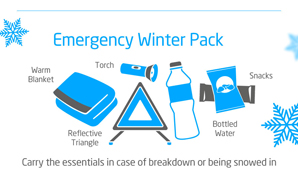

As the colder months continue, installers will needs to take more care on the roads as reduced visibility and hazardous road conditions increase the likelihood of a breakdown or accident. fuelGenie has compiled these simple winter driving tips to keep tradespeople safe on the roads this winter.
(CLICK TO VIEW FULL INFOGRAPHIC)
Snow and ice
Stopping distances increase in snowy and icy conditions by up to 10 times. To avoid skidding on the road and losing control, drive so that you do not need to rely on your brakes to stop, and keep a good distance from the vehicle in front.
Plan work journeys around busy routes that will have been gritted and have high volumes of traffic to reduce the chance of skidding or vehicles getting stranded.
When snow is falling, use dipped headlights or fog lights to ensure that the vehicle is visible to other drivers on the road. When snow is no longer falling, make sure not to dazzle other drivers and pedestrians with the fog lights.
Visibility
Low-lying winter sun can affect vision when driving and lead to accidents on the road. Ensure your vehicle has optimum visibility with these checks:
Tyres
Consider changing to winter tyres to improve traction and grip on slippery road surfaces. Although the legal limit for minimum depth of tread is 1.6mm, the recommendation for tyre tread during winter is 3mm, as once it gets below this point the stopping distance in an emergency increases dramatically.
Loose gravel, road salt and potholes can take their toll on tyres throughout the colder months. However, by taking preventative measures such as checking tread and pressure every few weeks, you can help minimise potential vehicle downtime.
Battery
As it gets darker and colder, the increased use of lights, heaters and wipers puts greater demands on the car battery. To save your battery:
Oil
It’s worth considering that many vehicles need thinner oil this time of year because thick oil does not flow as freely in the cold as it does in warm weather. The next time you need to top up the oil levels consider spending an extra couple of pounds to save you money in the long run.
Emergency winter pack
It may seem an extra hassle but making sure your vehicle has its own emergency winter pack provides comfort and relief in the case of a breakdown. This ensures drivers are comfortable and able to access essentials such as a warm blanket, torch, bottled water and snacks.
fuelGenie is a supermarket fuel card provider.
If you'd like to keep up-to-date with the latest developments in the heating and plumbing industry, why not subscribe to our weekly newsletters? Just click the button below and you can ensure all the latest industry news and new product information lands in your inbox every week.